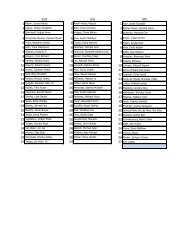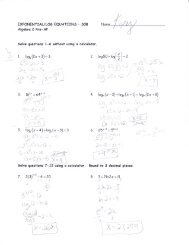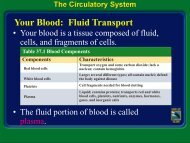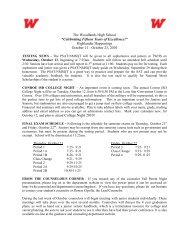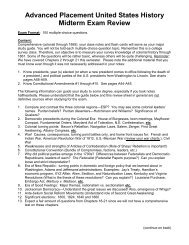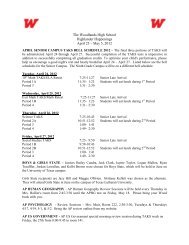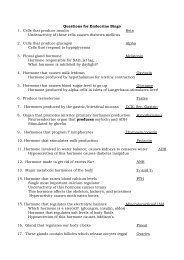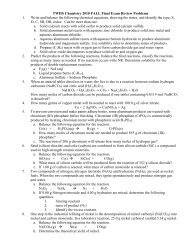Principles of Technology - Final Exam Review
Principles of Technology - Final Exam Review
Principles of Technology - Final Exam Review
You also want an ePaper? Increase the reach of your titles
YUMPU automatically turns print PDFs into web optimized ePapers that Google loves.
<strong>Principles</strong> <strong>of</strong> <strong>Technology</strong> - <strong>Final</strong> <strong>Exam</strong> <strong>Review</strong><br />
Answer Section<br />
SHORT ANSWER<br />
1. heat mover<br />
2. to change electrical energy to mechanical energy<br />
3. Bernoulli’s<br />
4. electromagnetic induction<br />
5. heat engine<br />
6. generator<br />
7. rubber band, spring, golf ball, bow<br />
8. refrigerator, air conditioner<br />
9. watts<br />
10. KE = 1/2 m x v 2<br />
11. Bernoulli’s principle<br />
12. GPE = m × 9.8 m/s 2 × h<br />
13. electrical power<br />
14. C<br />
15. D<br />
16. law <strong>of</strong> conservation <strong>of</strong> energy<br />
17. P = I x V<br />
18. 746 W<br />
19. P = F x d<br />
t<br />
= 160 N x 1 m<br />
0.5 s<br />
= 320 W<br />
20. F = F x d<br />
t<br />
= 700 N x 6 m<br />
6 s<br />
= 700 W<br />
21. I = P/V<br />
= 100 W/110 V<br />
= 0.909 A (0.91 A)<br />
22. GPE = m x 9.8 m/s 2 x h<br />
= 4.0 kg x 9.8 m/s 2 x 3.0 m<br />
= 117.6 J
23. KE = 1/2m x v 2<br />
=1/2(20kg) x (2 m/s) 2<br />
= 40 J<br />
24. I = P/V<br />
= 1800 W/210 V<br />
= 8.57 A<br />
25. It is determined by the density <strong>of</strong> the medium at the compressions.<br />
26. It is destructive; troughs <strong>of</strong> one wave meet crests <strong>of</strong> the other wave.<br />
27. hertz<br />
28. A medium is the material through which a mechanical wave travels.<br />
29. transverse<br />
30. longitudinal<br />
31. decibels<br />
32. a longitudinal wave<br />
33. In wave B, one wavelength equals the distance between neighboring crests.<br />
34. transverse<br />
35. standing wave<br />
36. nodes, four<br />
37. compression<br />
38. B, A ,C<br />
39. velocity = frequency × wavelength<br />
40. V = f x λ = 10 m × 20 Hz = 200 m/s<br />
41. f = V/λ<br />
= 13.2 m/s/0.03 m<br />
= 440 Hz<br />
42. V = f x λ<br />
= 2.0 Hz × 10 m<br />
= 20 m/s<br />
43. λ = V/f<br />
= 5 m/s/2.5 Hz<br />
= 2 m<br />
44. f = V/λ<br />
= 10.5 m/s/0.15 m<br />
= 70 Hz<br />
45. The angle at which light strikes a surface is the same as the angle at which it is reflected.<br />
46. reflected ray<br />
47. angle <strong>of</strong> incidence<br />
48. incident ray<br />
49. angle C
50. A bundle or packet <strong>of</strong> light energy.<br />
51. total internal reflection<br />
52. convex<br />
53. concave<br />
54. diffuse<br />
55. regular<br />
56. convex lens<br />
57. concave lens<br />
58. Nuclear fusion is a process that fuses two light nuclei to form a heavier nucleus.<br />
59. nuclear fission—splitting a nucleus into two smaller nuclei; nuclear fusion—uniting two nuclei to<br />
form a larger nucleus<br />
60. alpha - two protons and two neutrons, beta - high-speed electron (positron) emitted from the<br />
nucleus, gamma - high energy electromagnetic radiation<br />
61. nuclear fusion<br />
62. An isotope <strong>of</strong> an element has atoms with the same number <strong>of</strong> protons (the number <strong>of</strong> protons is<br />
what identifies the element), but a different number <strong>of</strong> neutrons.<br />
63. a chain reaction<br />
64. 50°<br />
65. iron, nickel, cobalt<br />
66. atoms in magnetic materials that have their north and south poles aligned<br />
67. areas <strong>of</strong> a magnet where the magnetic force is strongest<br />
68. unlike poles<br />
69. the area around a charged object where the electric force can affect other objects<br />
70. It decreases the voltage.<br />
71. step-down transformer<br />
72. 12 V<br />
73. accumulation <strong>of</strong> excess electric charges on an object<br />
74. charging by contact and charging by induction<br />
75. a large discharge <strong>of</strong> static electricity<br />
76. They hang straight down.<br />
77. The leaves repel each other.<br />
78. 2nd class<br />
79. 7<br />
80. 3<br />
81. A - movelable pulley B - block and tackle C - fixed pulley<br />
82. Fossil fuels are nonrenewable and will become depleted.<br />
83. Devices that produce electricity from solar energy<br />
84. Energy from falling water<br />
85. Hot magma
86. tidal energy



